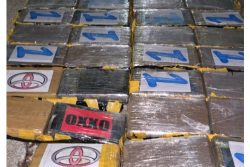Following a question by Stabroek News, ExxonMobil has said it will not disclose its estimated cost of production for oil to be extracted from the Liza-1 well in 2020.
In a statement to this newspaper, the company said “We typically don’t share that information but we work closely with the government on estimated costs and production plans. Upon start-up, we’ll have a small ramp-up period to full production. Apart from periodic maintenance, we plan to operate at full capacity”.
ExxonMobil’s disregarding of local interest in its cost of oil production, while not unexpected, exemplifies its unwillingness to be fully accountable in each jurisdiction that it operates in even if it is not `typical’ or jars with its corporate governance principles. It is hoped that it would adopt a more enlightened position and provide detailed information on its estimated cost of production from the Liza-1 well and later on for extraction from the multiple wells in and around Liza-1 which will be attended by various cost mitigating factors.
Every single Guyanese, and most importantly, their government should be acutely interested in the cost of production of a barrel of oil from ExxonMobil as it is, of course, the key determinant of how much money will accrue to the country in 2020 from oil extraction and onwards.
Based on the Production Sharing Agreement (PSA) of 2016 which the government clandestinely concluded with ExxonMobil’s subsidiary, Esso Exploration and Production Guyana Limited (EEPGL), Guyana takes 2% as royalty from the gross oil production. Of the remainder of the oil, ExxonMobil can claim as much as 75% as cost oil or the cost of producing the oil plus recoveries of its varied demands such as the pre-contract costs. The remaining 25% of the oil is to be split evenly between Guyana and EEPGL/ExxonMobil. Guyana’s revenue will then be 2% royalty plus the 12.5% multiplied by what the prevailing price per barrel of oil is at the time.
As has been painstakingly pointed out by a number of commentators such as Christopher Ram and Tarron Khemraj, the quantum of money accruing to Guyana is heavily dependent on ExxonMobil’s cost of production as this will account for a significant portion of the 75% of cost oil. Presumably, the Government of Guyana and EEPGL can negotiate whether cost oil can be lower than 75% in the initial years but given the disastrous performance of those who have negotiated on behalf of this country in oil and gas matters there cannot be much optimism there.
What is unlikely to be negotiated is the cost of producing a barrel of oil that EEPGL will present to the Guyana Government in 2020. This will be transmitted as a given but if it were US$10 above the real cost of production it means that Exxon will be able to take more from the oil revenues than it is entitled to. This is what the Government of Guyana has to guard against as a trustee of the people’s interest and as the guardian of the country’s natural resources. So what will the government do?
Various estimates have been given by government officials of what they estimate revenues to Guyana will be in 2020 and the years beyond. The latest figure has come from Minister of Finance Winston Jordan. He estimated revenue in 2020 at US$300m at 120,000 barrels of oil per day. No information was provided by him on the expected cost of production per barrel of oil.
Minister Jordan would be expected to present the 2020 budget in around a year’s time. That would be the ultimate deadline for the government to have a clear fix on what EEPGL will be claiming as cost of production. It would also be the point at which the public should be clearly told the assumptions that the government is making about the price per barrel of oil on the international market, whether any long-term oil sales arrangements are being envisaged and whether there would be any hedging to protect the country from the continuing volatility in the oil market.
Guyana should therefore be prepared. Given the infancy of the oil production relationship between the government and ExxonMobil it should be tested for goodwill. As part of its fiduciary responsibility to the people of this country, the government should make a formal request to EEPGL/ExxonMobil for a declaration of its projected cost of production in 2020 and beyond and the components of this computation. This information should then be made public. This is all-important and will be the ultimate driver of everything connected to the oil and gas industry and more particularly how much money will be available for the Natural Resource/Sovereign Wealth Fund.
It is difficult to see how ExxonMobil can refuse such a request given the fact that it has locked itself into what will be a decades-old relationship with the country but the government also has to be prepared for this eventuality. Once obtained, the projected cost of production should be widely exposed at academic seminars and workshops for an expert determination of whether the figure is reasonable or whether it should be vigorously contested when it is presented by EEPGL as oil production draws closer in 2020.
That would be a far more productive use of time on the country’s behalf as opposed to the parade of events on oil and gas by the private sector and a number of other organisations which are often just discursive talks without any particular aim in mind except for being noticed on the oil and gas stage. These private sector and civil society organisations should pool their resources for conjoint presentations that constantly try to distil what the public needs to know and what the government needs to tell rather than tripping over each other and rebooting basic positions.
ExxonMobil’s cost per barrel of oil and the testing of that figure should become immediate preoccupations of all of those interested in accountability. The government should be pressed to ensure that cost oil in 2020 is fairly and accurately composed.








